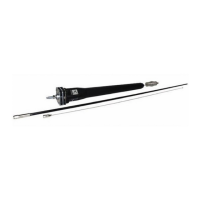Installing the antenna
Automatic Tuning Whip Antenna 9350 Installation Handbook 13
The RF earth differs from the DC earth required by the battery
and the vehicle’s electrics. For more information on power
supply factors and earthing the transceiver see the Reference
Manual provided with the transceiver.
Cabling
The coaxial cable between the antenna and the transceiver
should be installed as far as possible from other vehicle
wiring, especially high-tension ignition wiring or the engine
management computer.
The cabling must be in a position that:
• is away from the driver’s feet
• is secured and concealed as much as possible
• ensures the control and coaxial cables are separated from
the DC power cable by at least 200 mm (8 in) (except
over short distances, for example, to pass through the
same hole in a bulkhead)
• is secured behind protective metalwork (only if the
cables run under the vehicle)
Keep cables in the engine compartment away from:
• heat, for example, exhaust, air-conditioning systems, and
water pipes
• oils and corrosive liquids, for example, engine oil,
battery fluid, and brake fluid
Protect all the cables from sharp edges and mechanical
abrasions. Cables that pass through body panels or internal
bulkheads must be protected by rubber grommets. Holes in the
bulkhead need only be large enough to allow the end of the
cable with the smaller connector to pass through. Removing a
connector should be a last resort.
CAUTION
Removal of factory-fitted connectors may cause
cable or connector faults.

